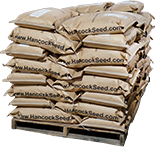Crimson Clover is commonly used for wildlife food plots, cattle forage and decorative ground cover planting.
Product Information
- Application or Use: Cattle Forage, Livestock Grazing, Food Plot, Cover Crop, Erosion Control
- Germination Time: 7 - 14 days, under optimal conditions
- Growing Locations: Warm Season, Transition Zone, Cool Season
- Height: 1 - 3 feet
- Sunlight Requirements: 4 - 6 hours
- Advantages: Produces more forage and ground cover, adapts to heavier, well drained soil.
- When to Plant: Recommended planting time is spring and fall when night time temperatures are consistently below 65 degrees.
Product Details
- Reseeding winter annual
- Best adapted to the heavier, well-drained soils
- Great for food plots, forage, and ground cover
- One of the most colorful forage plants
- Produces more forage at low temperatures than other clovers
Product Information
Crimson Clover is commonly used for wildlife food plots, cattle forage and decorative ground cover planting. Crimson clover (Trifolium incarnatum) is one of the most colorful forage plants and is frequently seen along roadsides, where it is planted for highway beautification. It is a reseeding winter annual with an erect growth habit and a shallow taproot system. The flowers are a brilliant red color, elongated in shape, and often more than two inches long. The leaves are dark green and covered with dense hairs.
Crimson clover is best adapted to the heavier, well-drained soils, performing poorly on dry, sandy, and poorly drained sites. Crimson clover produces more forage at low temperatures than other clovers. It is fairly tolerant of soil acidity and is often seeded in mixture with small grains and ryegrass. Crimson clover is also often seeded into warm-season perennial grass pastures (bermudagrass and bahiagrass) and may reseed under some management conditions.
*Product packaging may appear different than what is pictured.

Crimson clover seed should be planted at 20 to 26 pounds of seed per acre. Most improved crimson clover varieties are adapted to Florida conditions, but they vary in spring maturity. Seeds germinate in the fall, and plants produce very little top growth while developing a strong root system, so very little forage is available for grazing before February. Grazing should be delayed until 6-8 inches of growth accumulate. Terminate grazing when plants are 3-5 inches in height. Crimson then grows rapidly until flowering begins about mid-April. Forage is very high quality with both leaves and stems readily consumed. Although it is generally grazed, it may be harvested as high-quality hay or silage. If trying to manage for reseeding, reduce grazing pressure for about three weeks when in full flower.
Crimson Clover Seed - Coated
Crimson Clover is commonly used for wildlife food plots, cattle forage and decorative ground cover planting.

Instructions
For more info on planting instructions and tips for the best results – check out our Warranty & Planting Information here!
Crimson clover seed should be planted at 20 to 26 pounds of seed per acre. Most improved crimson clover varieties are adapted to Florida conditions, but they vary in spring maturity. Seeds germinate in the fall, and plants produce very little...





















